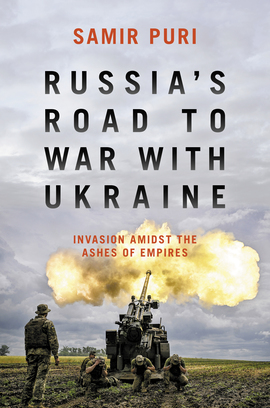Samir Puri, author of Russia’s Road to War with Ukraine, reflects on the anniversary of the invasion of Ukraine and what is likely to happen next.
 With all the talk of this bitterest of anniversaries – one year since Russia’s full-scale invasion of Ukraine – we forget one rather crucial thing. March 2023 will mark a closely related anniversary, which is nine years since Russia annexed the Crimean Peninsula and began stoking the first Donbas war in east Ukraine.
With all the talk of this bitterest of anniversaries – one year since Russia’s full-scale invasion of Ukraine – we forget one rather crucial thing. March 2023 will mark a closely related anniversary, which is nine years since Russia annexed the Crimean Peninsula and began stoking the first Donbas war in east Ukraine.
The bloodshed, suffering and geopolitical turmoil of this past year dwarfs anything that came before. But the sheer length of time that has elapsed since Russia and Ukraine first went to war in a more limited way offers a cautionary reminder of the stakes involved and the long aftermath that will likely follow any official end to this conflict.
We are not there yet; far from it, in fact, as Russia, Ukraine and Ukraine’s chief foreign backers gear up for so-called spring offensives. Russia is trying to conquer more territory in the four Ukrainian regions that Russian President Vladimir Putin declared as having been annexed last September (Donetsk, Luhansk, Kherson and Zaporizhzhia). Ukraine is fighting to prevent this and recapture its occupied territory. Where this all ends, no one knows, and it depends now on the skill, endurance and supplies of the opposing armies.
The road out of war
More broadly, however, we do know that since the road to this war was such a long one, the road out of it is likely to be generational. One of three scenarios is likely to be the reality by the time we reach the second anniversary of the full-scale invasion (and indeed, the decennial anniversary of the first Donbas war) in 2024.
- First, Ukraine inflicts deep blows on the existing Russian front line in Ukraine and, as a result, Putin’s domestic position becomes less tenable. Rather than celebrate on behalf of Ukraine, however, there is a cautionary tale as to what comes next in the Kremlin. Recall that back in the 1990s, Putin replaced former President Boris Yeltsin, promising to win the war in Chechnya after Yeltsin faced defeat there. Could a successor to Putin repeat this trick by being even more hardline and attacking Ukraine again in the future?
- Second, the sides are stalemated on the battlefield and, despite fighting hard, the front line looks relatively similar a year from now. Whether the sides can ever enter negotiations to bring hostilities to an end depends very much on outsiders encouraging them to do so. For instance, Ukraine’s Western allies could pressure it to accept talks, while Russia’s major Asian trading partners, India and China, could play a parallel role on the other side. There are huge hurdles to overcome. Ukrainian President Volodymyr Zelensky has said that he cannot countenance talks with Putin, and any deal to end the war would need to be cloaked in diplomatic ambiguities.
- Third, the sides simply carry on fighting, albeit at a reduced tempo, as the confidence each side has in its ability to prevail on the battlefield ebbs. For Ukraine, with its determined soldiers reliant primarily on the massive US security assistance in weapons and training, which has now reached the figure of $30 billion in one year, the biggest hazard is in a change of political winds in Washington DC. Imagine that a Republican President in the mould of Donald Trump – or indeed Trump himself – beats the incumbent Joe Biden in the 2024 US presidential election. Ukraine may find itself receiving a much-reduced flow of American arms and backing.
There are so many factors at play, and any combination of the above will spell a different road ahead. One thing is certain, however. Russia remains committed to devastating and dividing Ukraine, rather than allowing it to join intact such Western bodies as the EU or NATO.
As I have explained in my book, we caricature Russian war aims in Ukraine at our peril. Nothing can justify the murderous Russian invasion, but for Putin and his coterie of associated and would-be successors, there are real geopolitical and post-imperial motivations for waging this war. To end it, whether this year or next, guaranteeing Ukraine’s sovereignty and territory is only part of the puzzle. What to do with Russia, with all of its imperial hubris still on display, remains the toughest question of all.
Samir Puri’s book Russia’s Road to War with Ukraine is out now.
Want to hear more from Samir? Catch him in conversation on this episode of Biteback Chats Books, where he also reveals which three influential people he would give a copy of his book to and why.
